Volkswagen Golf SportWagen (2015 year). Instruction — part 16
Shifting
Introduction
In this section you’ll find information about:
Warning and indicator lights
Pedals
Manual transmission: Gearshift lever
Automatic transmission: Selector lever
Shifting with Tiptronic
®
Driving with automatic transmission
Automatic transmission malfunction
Gear recommendation
Explanatory notes in this section regarding automatic transmissions also apply to the DSG
®
automated transmission.
Your vehicle may be equipped with a special DSG
®
automated transmission that combines the per-
formance and economy of a standard manual transmission with the comfort and convenience of a
conventional automatic transmission. The DSG transmission housing contains two clutches, one that
works with the odd-numbered gears (1, 3, 5 and R) and the other that works with the even-numbered
gears (2, 4, 6). The dual clutch configuration enables rapid shifts between gears without loss of trac-
tion as the dual clutch seamlessly transfers the engine power from one driveshaft to the other during
gear shifts. An output shaft for each of the two gearbox units transmits the drive to the driven wheels
via a differential. The DSG electronic control unit, sensors, and hydraulic control for clutch engage-
ment and gear selection form one compact weight-saving unit.
Thanks to the dual-clutch design, the DSG system is more efficient than a conventional automatic
transmission. For example, while idling, a torque converter in a conventional automatic transmission is
engaged all the time (increasing load and engine fuel consumption), while the DSG gradually opens
the clutch, allowing the engine to idle freely. In most cases, this efficiency combined with its low weight
and intelligent control means that DSG can achieve the same or better fuel consumption than a manu-
al transmission. The clutches, like the clutch in a standard manual transmission are subject to wear
over time. The DSG transmission requires periodic maintenance that is described in the
⇒ Chapter
Warranty and Maintenance.
When the ignition is switched on and the transmission is in Reverse (R):
The backup lights come on.
The rear window wiper switches on when the windshield wipers are switched on.
The Rear View Camera system switches on (if equipped).
More information:
Lower center console
Instruments
Braking and parking
Rear View Camera system
Climate control
Engine control and emission control system
Emergency closing and opening
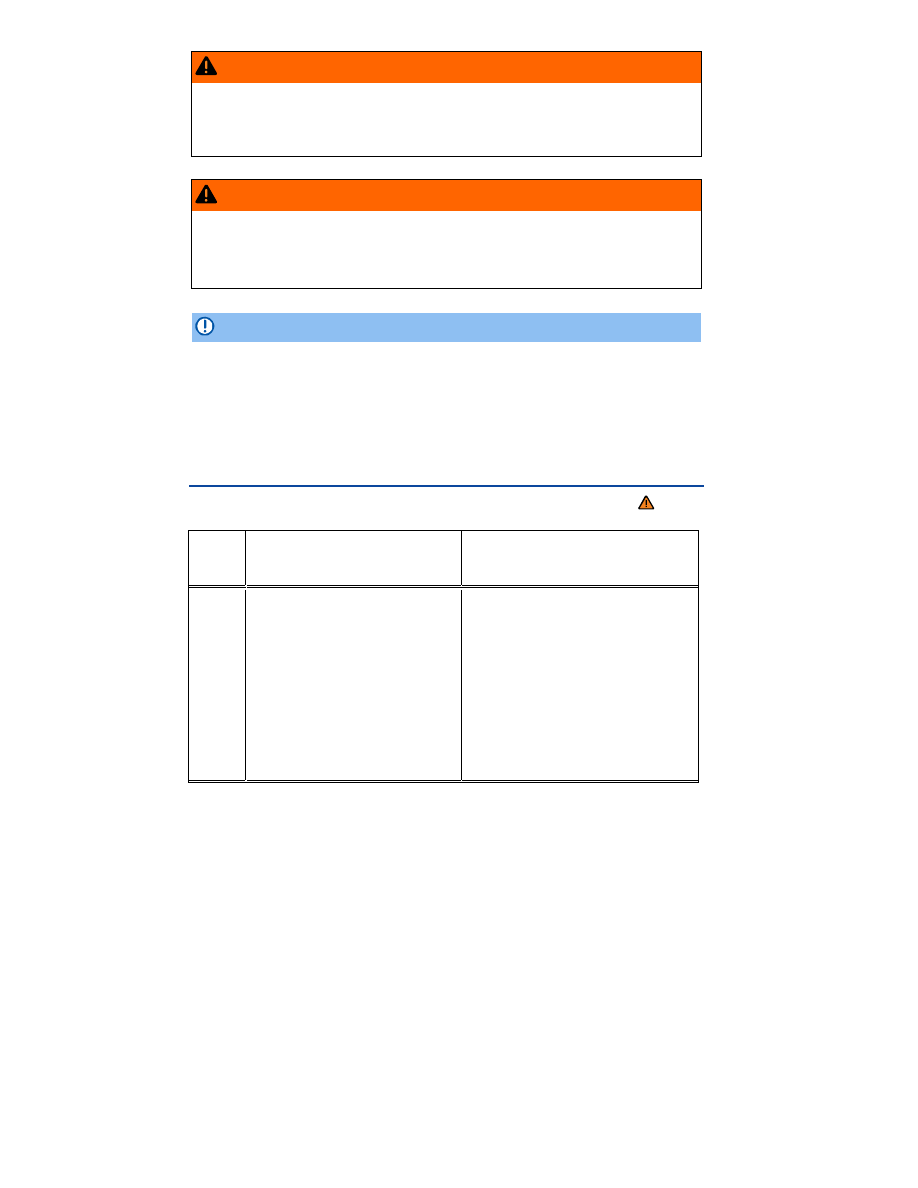
WARNING
Rapid acceleration can cause skidding and loss of traction, especially on slippery roads,
resulting in a loss of vehicle control, collisions, and serious personal injury.
Only use the kick-down feature or fast acceleration if visibility, weather, road, and traffic
conditions permit and other drivers will not be endangered by your driving and the vehicle's
acceleration.
WARNING
Constant braking causes the brakes to overheat and even to fail leading to collisions and
serious personal injury.
Never “ride” the brakes or apply the brake pedal too often or too long.
Riding the brakes will substantially reduce braking performance, increase stopping dis-
tance, and can cause complete brake system failure.
NOTICE
Never “ride” the brakes by keeping your foot on the brake pedal when you do not want to
brake. This will make the brakes wear faster.
Before driving downhill, especially on hills that are long or steep, always reduce speed and
shift into lower gear (manual or automatic transmission). This will let the vehicle use engine
braking and reduce the load on the brakes. Otherwise, the brake system could overheat and
even fail. Only use the brakes when you need them to slow the vehicle down more or to stop.
Warning and indicator lights
Please first read and note the introductory information and heed the WARNINGS
Lights
up
Possible cause
Proper response
Transmission malfunction.
Do not continue driving!
Allow the transmission to cool
with the selector lever in the P
position.
If the warning does not turn off,
do not continue driving. See your
authorized Volkswagen dealer for
assistance. Otherwise, serious
transmission damage could re-
sult
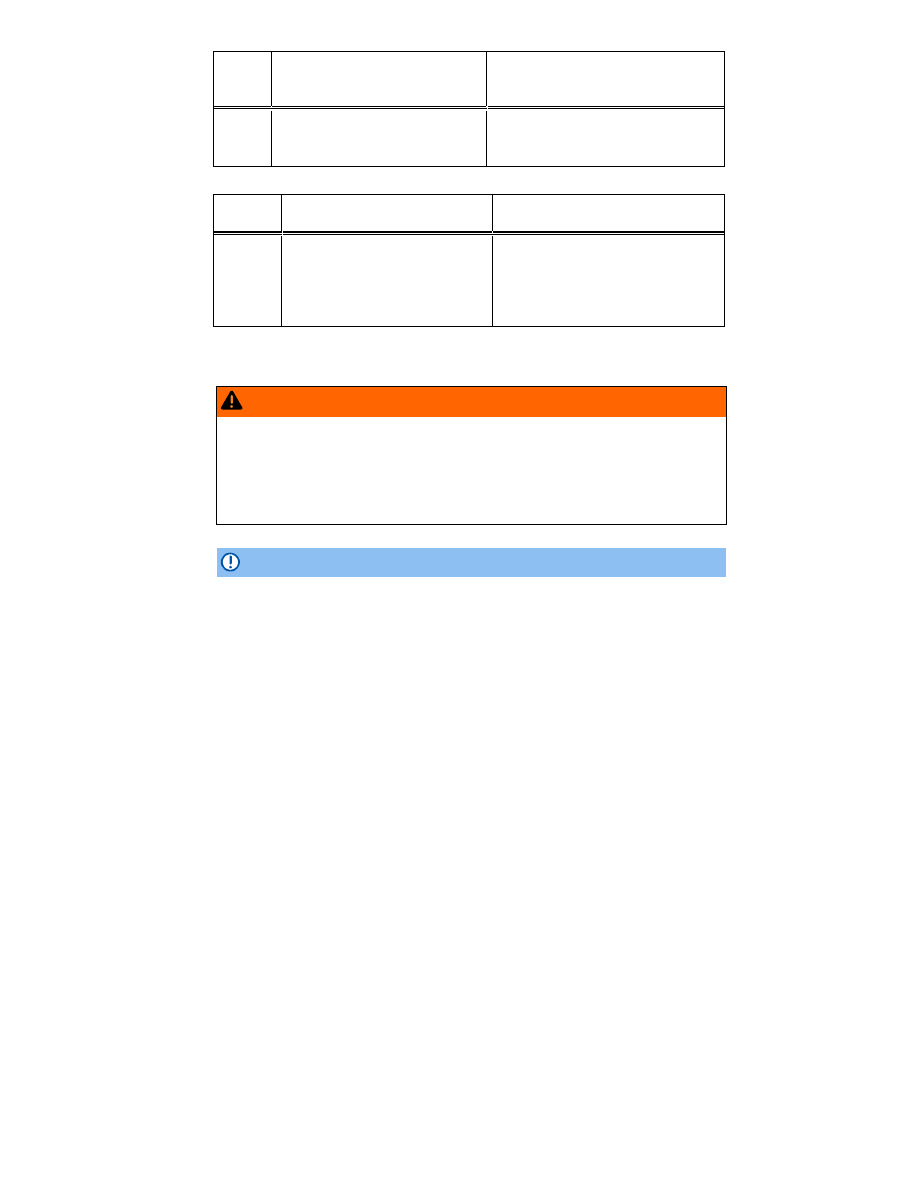
Lights
up
Possible cause
Proper response
Brake pedal not depressed.
Apply the brake pedal to select a
drive gear
Flashes
Possible cause
Proper response
The release button in the
selector lever did not engage.
Vehicle movement is pre-
vented.
Engage selector lever release
button
When the ignition is switched on, several warning and indicator lights come on briefly for a function
check. They go out after a few seconds.
WARNING
Failure to heed warning lights and instrument cluster text messages can cause the vehicle to
break down in traffic and result in a collision and serious personal injury.
Never ignore warning lights or text WARNINGS.
Always stop the vehicle as soon as it is safe to do so.
Whenever stalled or stopped for repair, move the vehicle a safe distance off the road, turn
on the emergency flashers, stop the engine, and use other warning devices to warn ap-
proaching traffic.
NOTICE
Failure to heed warning lights or text WARNINGS can result in vehicle damage.
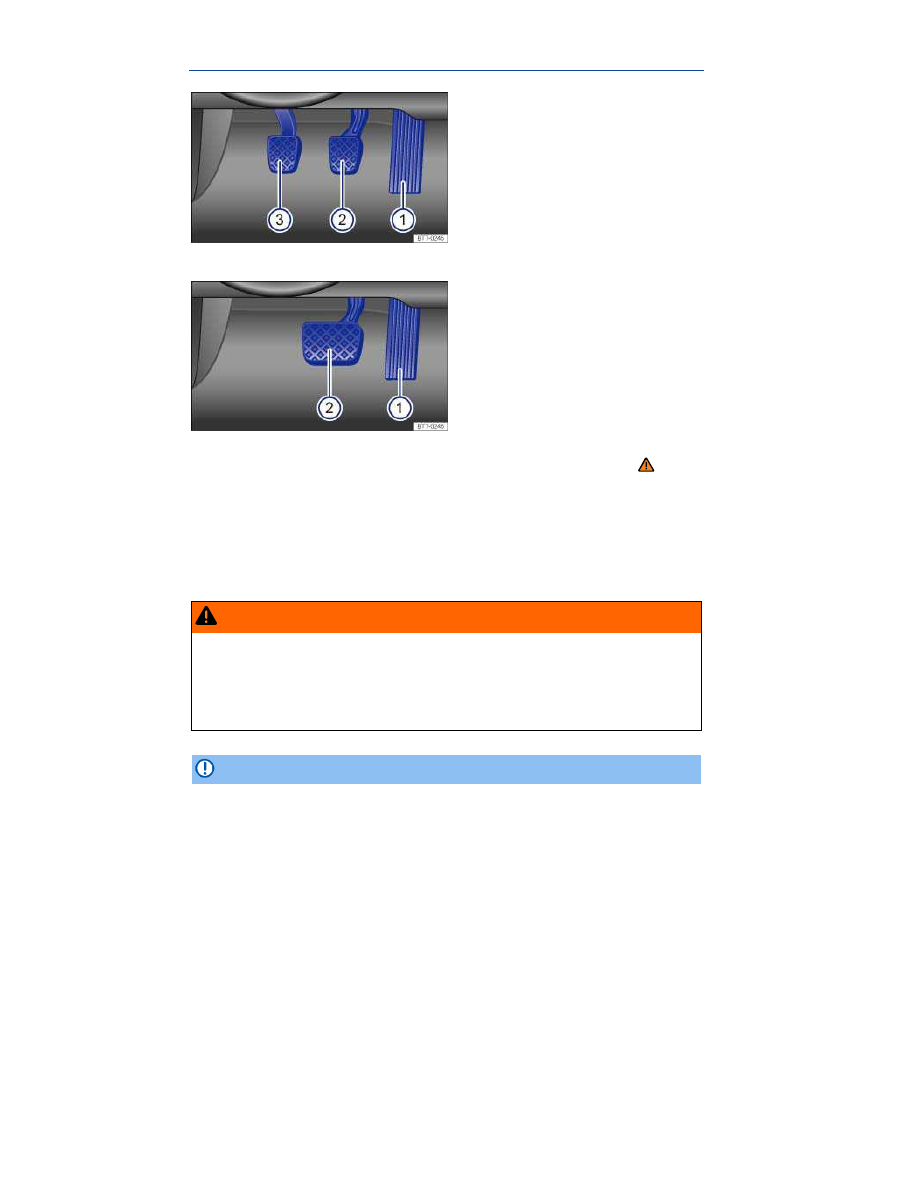
Pedals
Fig. 131 Pedals in vehicles with manual transmission: 1 Accelerator pedal, 2 Brake pedal, 3 Clutch pedal.
Fig. 132 Pedals in vehicles with automatic transmission: 1 Accelerator pedal, 2 Brake pedal.
Please first read and note the introductory information and heed the WARNINGS
All pedals must always be able to move freely in and out without interference from floor mats or other
things.
Only use floor mats that leave the pedal area free and are held securely in place with floor mat fasten-
ers to help prevent sliding.
If a brake circuit malfunctions, more brake pedal travel is needed to bring the vehicle to a full stop, and
it is important that nothing is in the way when you have to depress the brake pedal harder and farther
than normal.
WARNING
Objects in the driver footwell can prevent the pedals from moving freely. This can cause loss
of vehicle control and increase the risk of serious personal injuries.
Always make sure that nothing can interfere with the pedals.
Always fasten floor mats securely to the floor.
Never put floor mats or other floor coverings on top of already installed floor mats.
Always make sure that nothing can fall into the driver footwell while the vehicle is moving.
NOTICE
Always make sure that the pedals are able to move freely and that nothing can interfere with
them. If a brake circuit fails, more brake pedal travel will be needed to bring the vehicle to a
stop. The brake pedal must be pressed farther and harder than normal.
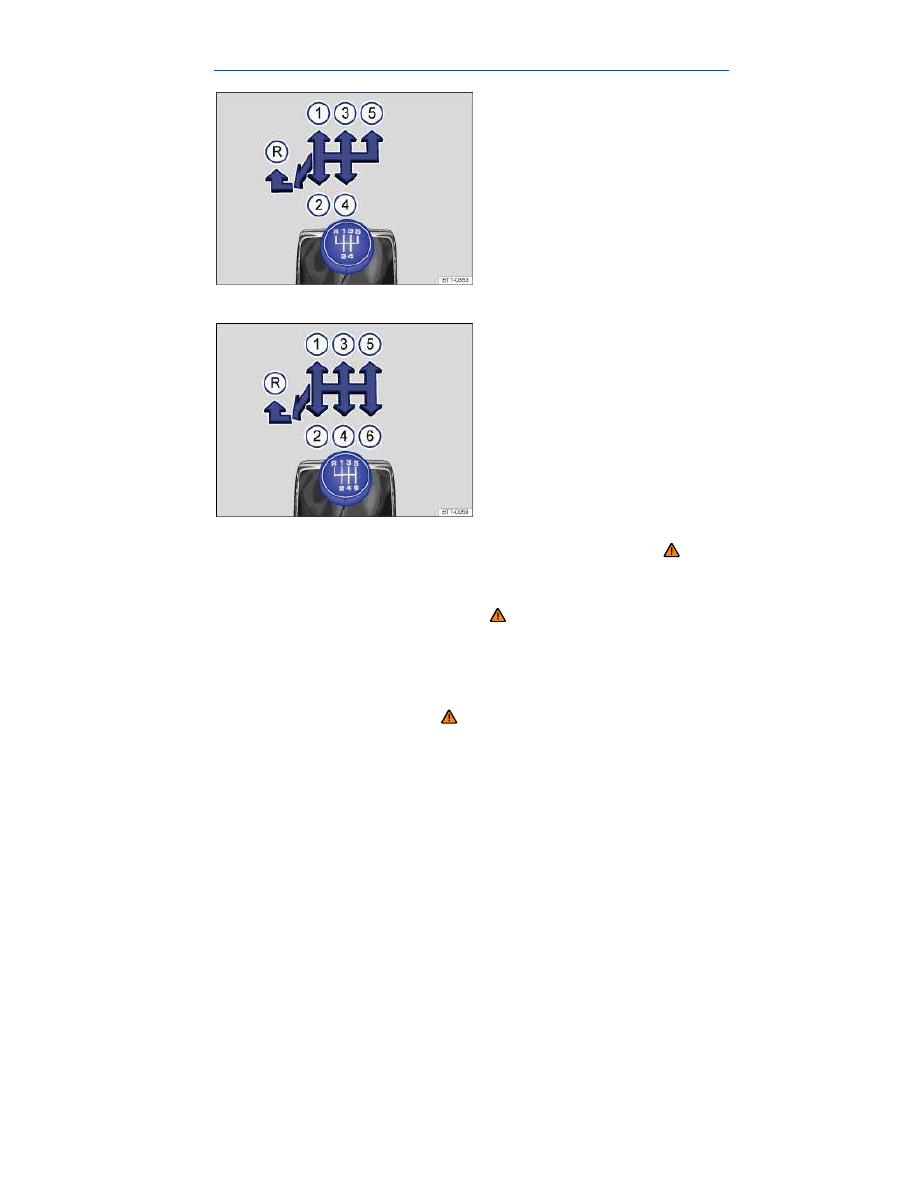
Manual transmission: Gearshift lever
Fig. 133 Gearshift pattern of a 5-speed manual transmission.
Fig. 134 Gearshift pattern of a 6-speed manual transmission.
Please first read and note the introductory information and heed the WARNINGS
The positions of the individual gears are shown on the gearshift lever
⇒
fig. 133
or
⇒
fig. 134
.
Depress the clutch pedal all the way and hold.
Move the gearshift lever into the desired position
⇒ .
Release the clutch pedal to engage the gear.
The clutch pedal must be fully depressed to start the engine.
Shifting into reverse
Only shift to the reverse gear when the vehicle is not moving.
Depress the clutch pedal fully and hold
⇒ .
Move the gearshift lever to neutral and press down.
Move the shift lever to the left and then push forward into the reverse gear position
⇒
fig. 133
(R)
or
⇒
fig. 134
(R)
.
Release the clutch pedal to engage the gear.

Downshifting
You should always downshift gear by gear when driving, meaning always into the next lowest gear. Do
not downshift when the engine rpm (revolutions per minute) is too high
⇒ . At fast speeds or high
engine rpm, skipping over one or more gears when downshifting can cause damage to the clutch and
transmission, even if a gear is not engaged
⇒ .
WARNING
Downshifting to a lower gear incorrectly can result in loss of vehicle control and can cause
accidents and serious personal injuries.
WARNING
When the engine is running and a gear is engaged, the vehicle will start to move as soon as
the clutch pedal is released. This also applies when the parking brake is engaged.
Never shift into Reverse (R) when the vehicle is moving.
NOTICE
Shifting down to a gear that is too low when driving at fast speeds or high engine rpm can
cause extensive damage to the clutch and transmission. That is true even if the clutch pedal is
pressed so that the clutch is not engaged.
NOTICE
To help prevent damage and premature wear:
Do not rest your hand on the gearshift lever while driving. Over time, the pressure will
cause premature wear in the transmission.
Make sure that the vehicle has come to a complete stop before shifting into Reverse (R).
Always depress the clutch pedal all the way when changing gears.
Do not hold the vehicle on a hill using engine power with the clutch pedal partially engaged
and the engine running.
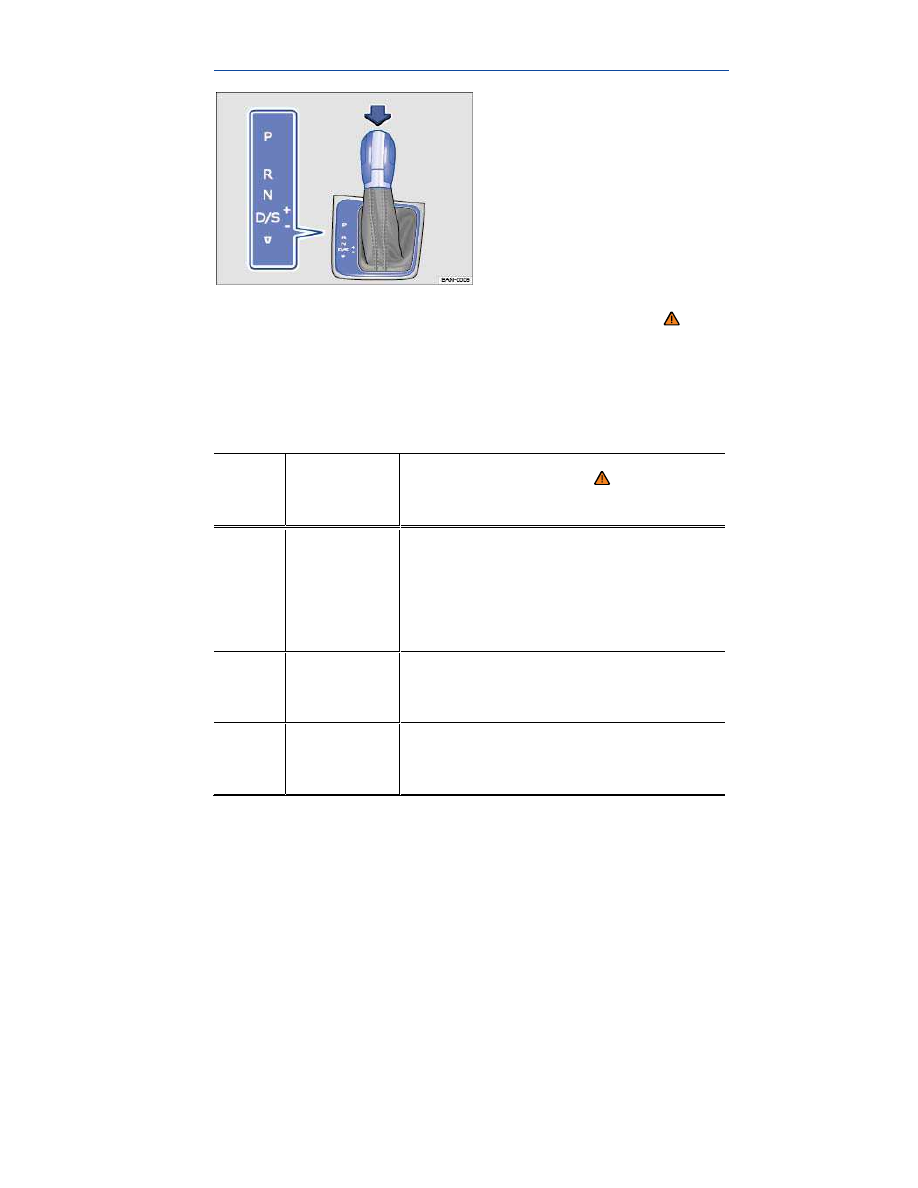
Automatic transmission: Selector lever
Fig. 135 Automatic transmission selector lever with shift lever release button (arrow).
Please first read and note the introductory information and heed the WARNINGS
Automatic transmission vehicles have an Automatic Shift Lock (ASL). With ASL, you must switch on
the ignition, depress the brake pedal and hold it down while pressing the release button on the selec-
tor lever handle in the direction of the arrow
⇒
fig. 135
to move the selector lever out of Park (P) and
into a drive gear. When the selector lever is in Neutral (N), you also have to depress the brake pedal
before you can move the selector lever to position (D/S), or Reverse (R).
If the ignition is switched on, either the current selector lever setting or the current gear is shown in the
instrument cluster display.
Selector
lever
position
Designation
Meaning
⇒
Park
The drive wheels are mechanically locked.
Select only when the vehicle is not moving. To
change the selector lever position, switch on
the ignition (if it is off) and then press the se-
lector lever release button while holding down
the brake pedal.
Reverse
The Reverse gear is engaged.
Shift into Reverse only when the vehicle is not
moving.
Neutral
Transmission is in Neutral position. No power
is transmitted to the wheels and no engine
braking is available.

Selector
lever
position
Designation
Meaning
⇒
/
Drive (stand-
ard driving
position)
OR
Sport drive
(sport driving
position)
Standard driving position D:
All forward gears shift up and down automati-
cally. The transmission shifts as needed de-
pending on engine load, individual driving
style, and vehicle speed.
Sport driving position S:
All forward gears automatically upshift later
and downshift earlier than in position D to take
full advantage of the engine's power reserves.
The transmission shifts as needed depending
on engine load, individual driving style, and
vehicle speed. The system will not, however,
switch to the highest forward gear.
The timing of the gear shift is determined by
the engine load, your individual driving style,
and the vehicle speed.
Changing
gear selection
Switch between Drive (D) and Sport drive (S)
by pulling the selector lever once to the rear
from gear position D/S
⇒
fig. 135
. The selector
lever always returns to gear position D/S.
It is possible to access Tiptronic selection from
gear position D/S when either Drive (D) or
Sport drive (S) is active
Automatic Shift Lock (ASL)
The Automatic Shift Lock (ASL) in Park (P) and Neutral (N) prevents drive positions from being en-
gaged inadvertently, which would cause the vehicle to move.
To release the ASL, depress and hold the brake pedal with the ignition switched on. Press the release
button on the selector lever at the same time.
The ASL is not engaged if the selector lever is moved quickly through Neutral (N) (e.g., when shifting
from Reverse (R) to Drive (D/S)). This makes it possible to “rock” the vehicle backwards and forwards
if it is stuck in snow or mud. The ASL engages automatically if the brake pedal is not depressed and
the lever is in Neutral (N) for more than about 1 second and the vehicle is traveling no faster than
about 3 mph (5 km/h).
In rare cases, the ASL may not engage on vehicles with a DSG
®
automated transmission. If this
happens, power to the drive wheels will be interrupted to prevent the vehicle from moving unexpected-

ly. The green indicator light will blink and a text message will be displayed. To engage the Automat-
ic Shift Lock (ASL):
Depress and then release the brake pedal. Try to engage the ASL again.
WARNING
Moving the selector lever to the wrong position can cause loss of vehicle control, a collision,
and serious personal injury.
Never accelerate when moving the selector lever.
When the engine is running and a drive position is engaged, the vehicle will start to move
as soon as the brake pedal is released.
Never shift into Reverse (R) or Park (P) when the vehicle is moving.
WARNING
Unintended vehicle movement can cause serious personal injury.
Never get out of the driver's seat while the engine is running, especially when the trans-
mission is in a drive gear. If you must leave your vehicle while the engine is running, always
set the parking brake and shift the transmission into Park (P).
Never leave the vehicle in Neutral (N). It will roll down hills, whether the engine is running
or not.
When the engine is running and a drive gear - Drive or Sport Drive (D/S) or Reverse (R) -
has been selected, press and hold the brake pedal to keep the vehicle from moving. The ve-
hicle may “creep” and move forward or backward even if the engine is idling slowly.
Never shift into Reverse (R) or Park (P) when the vehicle is moving.
NOTICE
Even though the transmission is in Park (P), the vehicle may move a couple of inches (a few
centimeters) forwards or backwards if you take your foot off the brake pedal after stopping the
vehicle without first setting the parking brake.
If the selector lever is moved into Neutral (N) by mistake when the vehicle is moving, take your
foot off the accelerator pedal. Wait until the engine speed has dropped to idle speed before moving
the selector lever into a drive gear.
Leaving the selector lever for a long period of time in any position other than Park (P) when the
ignition is switched off can drain the vehicle battery.
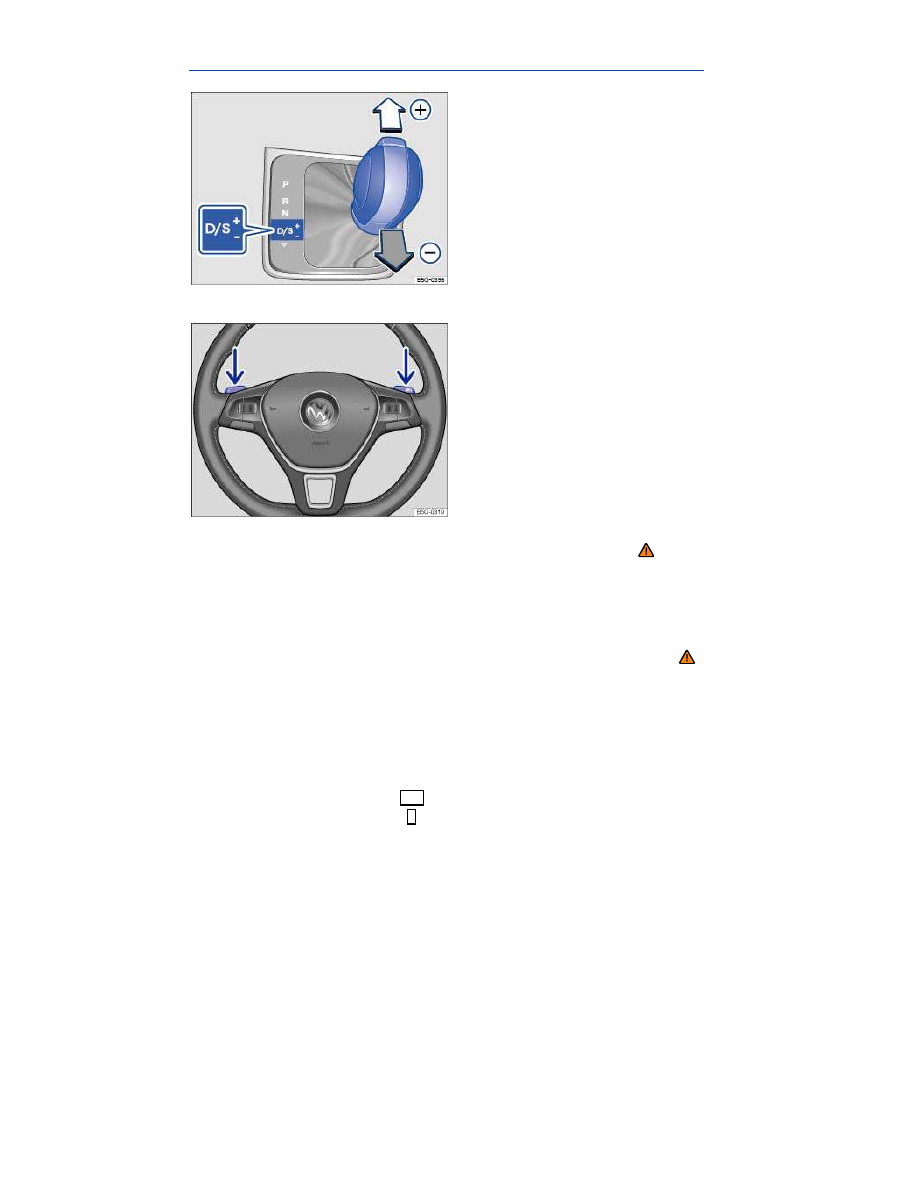
Shifting with Tiptronic
®
Fig. 136 Selector lever in Tiptronic position.
Fig. 137 Steering wheel with Tiptronic shift paddles (if equipped).
Please first read and note the introductory information and heed the WARNINGS
Tiptronic lets you upshift and downshift manually with the automatic transmission. When Tiptronic
mode is used, the transmission stays in the current gear and does not upshift or downshift automati-
cally unless the transmission senses a situation where upshifting or downshifting is necessary to keep
the engine from over- or under-revving.
Using Tiptronic with the selector lever
Push the selector lever sideways to the right from the D/S position into the Tiptronic position
⇒
in Automatic transmission: Selector lever
Briefly push the selector lever forward
(+)
to upshift into a higher gear or backward
(–)
to downshift
into a lower gear
⇒
fig. 136
.
Using Tiptronic with the shift paddles behind the steering wheel (if equipped)
The paddles
⇒
fig. 137
(arrows) work when the selector lever is in the Tiptronic position or when
the selector lever is in Drive or Sport Drive (D/S). You do not have to move the selector lever over to
the right into the Tiptronic position.
To upshift, pull the paddle on the right +
toward you.
To downshift, pull the paddle on the left – toward you.

To switch off Tiptronic mode, pull the paddle on the right +
toward you and hold it there for
about 1 second.
Tiptronic will switch off automatically if the shift paddles have not been used for a while and the selec-
tor lever is not in the Tiptronic position.
NOTICE
During acceleration, the transmission will shift automatically into the next higher gear
before reaching maximum engine speed (rpm).
If you use Tiptronic to shift into a lower gear, the transmission will downshift only when
doing so will not over-rev the engine.
Driving with automatic transmission
Please first read and note the introductory information and heed the WARNINGS
All forward gears shift up and down automatically.
Driving on hills
The steeper the grade, the lower the gear that must be selected. Lower gears increase the braking
effect of the engine. Never coast downhill in Neutral (N).
Reduce speed.
Switch to Tiptronic mode by moving the selector lever from Drive or Sport Drive (D/S) to the right
into the Tiptronic position
⇒ Shifting with Tiptronic®.
Downshift by pulling the selector lever back briefly (-).
OR: Downshift using the paddles on the steering wheel
⇒ Using Tiptronic with the shift paddles
behind the steering wheel (if equipped).
If you stop and start up again when going uphill, you should use Hill Hold
⇒ Starting assistance sys-
tems as long as the engine is running.
Vehicles without Hill Hold: If you stop on a hill with the vehicle in gear, you must depress the brake
pedal or engage the parking brake to keep the vehicle from rolling. Do not release the brake pedal or
the parking brake until the vehicle has started to move forward
⇒ .
Kick-down acceleration
The kick-down feature permits maximum acceleration when the selector lever is in the Drive or Sport
Drive (D/S) position or in Tiptronic mode.
If you push the accelerator all the way down, the vehicle will automatically downshift, depending on
vehicle speed and engine speed (rpm). This feature lets you take advantage of the full acceleration
capacity of the vehicle
⇒ .
With kick-down actuated, the transmission will stay in the current gear longer and not upshift until the
engine reaches maximum rpm.

WARNING
Rapid acceleration can cause skidding and loss of traction, especially on slippery roads,
resulting in a loss of vehicle control, collisions, and serious personal injury.
Only use the kick-down feature or fast acceleration if visibility, weather, road, and traffic
conditions permit and other drivers will not be endangered by your driving and the vehicle's
acceleration.
Always adapt your driving to the traffic flow.
Note that the drive wheels can spin and the vehicle can swerve when ASR is switched off,
especially when the road is slippery.
Once you have accelerated, switch ASR back on again.
NOTICE
When stopping on hills with the transmission in a drive gear, do not use the accelerator to
help prevent the vehicle from rolling backwards. This can cause the automatic transmission to
overheat and be damaged.
Never let the vehicle coast or roll down a hill in Neutral (N), especially when the engine is
not running. The transmission will not be lubricated and will be damaged.
Automatic transmission malfunction
Please first read and note the introductory information and heed the WARNINGS
Emergency shift program
If all selector lever position indicators in the instrument cluster display are highlighted against a bright
background, there is a system malfunction. The automatic transmission or the DSG
®
automated
transmission will then operate in the emergency shift program. The emergency shift program lets you
drive the vehicle, but at a reduced speed and without being able to use all of the forward gears.
In some cases, vehicles with a DSG
®
automated transmission may not be able to shift into reverse.
It is then impossible to drive the vehicle backwards.
In any event, have the automatic transmission checked by an authorized Volkswagen dealer or author-
ized Volkswagen Service Facility.
Overheating of the DSG
®
automated transmission
The DSG transmission may overheat, for example, due to frequent starts, extended “creeping,” or
stop-and-go traffic. Overheating is indicated by the warning light and, if applicable, by a text mes-
sage in the instrument cluster. An additional warning chime may sound. Stop and let the transmission
cool down
⇒ .
The vehicle does not move forward or in reverse even though a drive position is selected
with the selector lever
If the vehicle does not move in the desired direction, the system may not have engaged the drive
position correctly. Press the brake pedal and select the drive position again.
If the vehicle still does not move in the desired direction, there is a system malfunction. See your
authorized Volkswagen dealer or authorized Volkswagen Service Facility for assistance to have the
system checked.

NOTICE
As soon as you get any of these warnings about transmission overheating, you must either
park the vehicle in a safe place or drive faster than 12 mph (20 km/h).
If the text message and acoustic warning repeat themselves every 10 seconds or so, you
must park the vehicle in a safe place as soon as you can safely do so and stop the engine. Let
the transmission cool down.
To help prevent damage to the transmission, do not drive the vehicle again until the acous-
tic warning has stopped. As long as the engine is overheated, avoid stop and start driving and
avoid low speeds (“walking pace”).
Gear recommendation
Fig. 138 In the instrument cluster display: Gear recommendation.
Please first read and note the introductory information and heed the WARNINGS
Your vehicle may be equipped with a gear recommendation feature. The gear recommendation dis-
plays a gear in the instrument cluster display that can help reduce fuel consumption.
For vehicles with an automatic transmission: The selector lever must be in the Tiptronic position
⇒
Shifting with Tiptronic®.
Key to
fig. 138
:
(A)
Current gear.
(B)
Recommended gear.
If the optimal gear is already selected, another gear is not recommended . Only the current gear is
displayed.
Information on “cleaning” the diesel particulate filter
The vehicle exhaust system detects when the diesel particulate filter is clogged and recommends a
specific gear to help the diesel particulate filter to clean itself. This may require driving at higher engine
rpm for a short time
⇒ Engine control and emission control system.
WARNING
The gear recommendation is only intended to assist the driver to select a gear for optimum
fuel economy. The gear recommendation cannot take road and traffic conditions into ac-
count.
The driver is responsible for selecting the correct gear for the current driving conditions,
such as when passing, when driving on hills or when towing a trailer.

WARNING
Obey all applicable legal requirements when cleaning the diesel particulate filter.
Clean the diesel particulate filter as recommended only when visibility, weather, road, and
traffic conditions permit.
Do not put others at risk.
Selecting the optimal gear helps to reduce fuel consumption.
The gear recommendation display turns off if you depress the clutch pedal (manual transmission)
or move the selector lever out of the Tiptronic position (automatic transmission).
Braking and parking
Introduction
In this section you’ll find information about:
Warning and indicator lights
Parking brake
Parking
About the brakes
Braking assistance systems
Switching Anti-Slip Regulation (ASR) on and off
Brake fluid
The braking assistance systems are the Anti-Lock Brake System (ABS), Brake Assist System
(BAS), Electronic Differential Lock (EDL), Anti-Slip Regulation (ASR), and Electronic Stability Control
(ESC).
More information:
Trailer towing
Tires and wheels
Starting assistance systems
Parts, accessories, repairs, and modifications
WARNING
Driving with bad brakes or worn brake pads can cause a collision and serious personal inju-
ry.
If the brake pads are worn or you notice changes in the way the vehicle brakes, immedi-
ately contact an authorized Volkswagen dealer or authorized Volkswagen Service Facility to
have the brake pads checked and, if necessary, replaced.

WARNING
Parking improperly can cause serious personal injury.
Never remove the key from the ignition switch or turn off the ignition with the starter but-
ton while the vehicle is moving or rolling to a stop. The electronic steering column could
suddenly lock, you would not be able to steer, and you could lose control of the vehicle,
crash, and seriously injure yourself and others.
Never park the vehicle where the hot exhaust system or catalytic converter could ignite
flammable materials, such as brush, leaves, dry grass, spilled fuel, etc.
Always apply the parking brake when parking your vehicle.
Improper use of the parking brake can seriously injure you and your passengers.
Never use the parking brake to slow down the vehicle when it is moving, except in an
emergency. The stopping distance is much longer because only the rear wheels are braked.
Always use the foot brake to stop the vehicle.
Never activate the throttle manually from the engine compartment when the engine is
running and the automatic transmission is in gear. The vehicle will start to move as soon as
the engine speed increases even if the parking brake is on.
Never leave children or anyone who cannot help themselves behind in the vehicle. They
could release the parking brake and move the gear selector lever or gear shift, which could
cause the vehicle to start moving. This can lead to a crash and serious personal injuries.
Always take the key with you when you leave the vehicle. The engine can be started and
vehicle systems such as the power windows can be operated, leading to serious personal
injury.
Never leave children, disabled persons, or anyone who cannot help themselves in the
vehicle. The doors can be locked with the remote control vehicle key, trapping passengers in
the vehicle in an emergency. For example, depending on the time of year, people trapped in
the vehicle can be exposed to very high or very low temperatures.
Heat buildup in the passenger and luggage compartment of a parked vehicle can result in
temperatures in the vehicle that are much higher than the outside temperatures, particularly
in summer. Temperatures can quickly reach levels that can cause unconsciousness and
death, particularly to small children.
NOTICE
Always be careful when you park in areas with parking barriers or high curbs. These vary in
height and could damage your bumper and related parts if the front of your vehicle hits a barri-
er or curb that is too high while you are getting into or out of a parking spot. To help prevent
damage, stop before the tires of your vehicle touch a parking barrier or curb.
Always be careful when you enter a driveway or drive up or down steep ramps or over
curbs or other obstacles. Parts of the vehicle close to the ground may be damaged (such as
bumper covers, spoilers, and parts of the engine, suspension, and exhaust systems).
Warning and indicator lights
Please first read and note the introductory information and heed the WARNINGS
Lights
up
Possible cause or meaning
⇒
Proper response

Нет комментариевНе стесняйтесь поделиться с нами вашим ценным мнением.
Текст